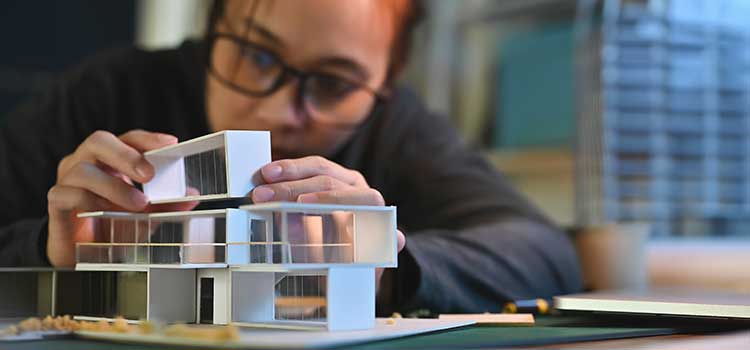Architect Interview Questions You Should Be Prepared to Answer
Architect Interview Questions You Should Be Prepared to Answer
Blog Article
Recognizing the Diverse Occupation Paths Available for Aspiring Architect
As an ambitious Architect, you have a world of job courses awaiting you. Each path supplies special challenges and chances to use your creative thinking and technological expertise. Whether you're drawn to conventional design or the subtleties of sustainable layout, there's a niche that lines up with your rate of interests. Recognizing these diverse options can form your professional journey, yet which instructions will you pick to explore initially?
Conventional Architecture: Designing Structures and Structures
Traditional design concentrates on making buildings and structures that blend capability with aesthetic appeal. As you explore this field, you'll appreciate the complex equilibrium in between form and objective. You'll find out to attract inspiration from historic designs, including aspects like symmetry, materials, and workmanship. Your layouts can mirror cultural heritage, showcasing local practices while satisfying contemporary requirements.
You'll create abilities in preparing, model-making, and site evaluation, allowing you to envision and connect your concepts effectively. Engaging with clients, you'll require to recognize their vision and equate it into practical styles.
In addition, developing codes and sustainability methods are important in your work, guaranteeing your structures are eco pleasant and risk-free. As you expand in your profession, you'll discover opportunities in household, commercial, or also restoration projects, each offering distinct difficulties. Accepting traditional style leads the way for a meeting career that pays tribute to the past while shaping the future.
Urban Planning: Forming Areas and Public Spaces
As an aspiring Architect, you can play a necessary duty as an urban organizer, changing exactly how neighborhoods operate and engage. By employing community interaction techniques, you'll assure that homeowners have a voice fit their setting. And also, integrating lasting design principles will help create spaces that not just meet today's demands however likewise protect the future.
Role of Urban Planners
While lots of could think of architects as the single enthusiasts behind structures, city planners play a vital function in forming the wider landscape of areas and public areas. By collaborating with different stakeholders, you'll help develop parks, transport systems, and domestic locations that promote social interaction and access. Your know-how in spatial layout and area characteristics allows you to visualize future development while protecting social heritage.
Community Involvement Strategies
Reliable community involvement techniques are essential for urban planners to assure that the voices of residents are listened to and valued in the planning process. To promote purposeful dialogue, you must focus on open discussion forums and workshops where neighborhood members can share their concepts and issues. Use studies and social media to get to a broader audience, making certain diverse viewpoints are consisted of. Teaming up with local organizations can improve trust and facilitate deeper links. It is essential to provide clear information concerning proposed projects and decision-making processes, permitting locals to feel enlightened and empowered. By proactively paying attention and incorporating feedback, you'll create spaces that show the community's needs, inevitably bring about even more successful and lasting urban environments. Welcome transparency and continuous discussion for long-term impact.
Lasting Style Concepts
When making city areas, incorporating sustainable layout concepts is important for producing environments that grow both environmentally and socially. Think about integrating environment-friendly rooms, like gardens and parks, to improve biodiversity and improve air top quality.
Creating with water conservation in mind is additionally essential-- think of rain yards and permeable surfaces to handle stormwater. Involving area members throughout the planning procedure assurances that the rooms you produce fulfill their requirements and encourage social communication. By accepting these concepts, you'll contribute to vivid, sustainable city landscapes that benefit every person.

Landscape Style: Creating Lasting Exterior Environments
As you explore landscape design, you'll discover important design principles that create practical and stunning exterior spaces. Sustainable methods play an essential role in ensuring these settings flourish while minimizing ecological effect. And also, you'll locate a selection of profession chances that permit you to make an actual distinction in just how individuals interact with nature.
Design Principles in Landscape
Understanding design principles in landscape architecture is vital for developing lasting outside atmospheres that balance with nature. You'll require to consider aspects like range, balance, and proportion to assure your layouts really feel cohesive and inviting. Incorporating indigenous plants not only boosts biodiversity yet likewise lowers water usage, making your landscape durable. Consider the flow of area and how individuals connect with it; paths and seating areas should welcome exploration and relaxation. In addition, focus on seasonal modifications, developing with materials that complement the surroundings year-round (Architect). By focusing on sustainability and aesthetics, you can develop outside rooms that enhance the community and advertise wellness. Welcoming these concepts will establish a strong structure for your career in landscape style.
Lasting Practices Overview
Sustainable techniques in landscape design not only concentrate on appearances however also prioritize eco-friendly health and wellness and source preservation. You can design rooms that promote dirt health and wellness, such try this out as utilizing natural materials and exercising permaculture principles. Inevitably, these methods guarantee your styles profit both people and the setting for years to come.
Profession Opportunities Expedition
With a strong structure in sustainable methods, landscape architecture uses a variety of occupation courses that enable you to make a meaningful influence on the setting. You could function as a landscape designer, creating visually pleasing and useful outdoor areas, or concentrate on environmental reconstruction, helping to restore damaged communities. Urban planners frequently work together with landscape architects to develop eco-friendly spaces in urban setups, improving city livability. If you're passionate regarding education and learning, think about becoming a landscape architecture instructor, motivating future generations. Additionally, you might collaborate with nonprofits concentrated on environmental sustainability or involve in study to innovate new techniques. Each course not only shapes attractive atmospheres yet likewise cultivates a healthier planet for future generations.
Sustainable Style: Focusing on Eco-Friendly Practices
As you discover your profession in architecture, accepting eco-friendly techniques can establish you apart in a competitive field. Sustainable design concentrates on producing structures that minimize ecological impact while improving occupant wellness. By integrating renewable products, energy-efficient systems, and sustainable building methods, you'll add to a greener future.
Beginning by gaining knowledge of environment-friendly certifications like LEED or BREEAM, which can boost your credentials. Take into consideration how all-natural light, air flow, and thermal efficiency can enhance layout. Collaborate with engineers and ecological professionals to introduce solutions that lower waste and preserve sources.
Do not neglect the importance of area involvement-- appealing regional stakeholders can inspire styles that integrate with the environment. As clients significantly prioritize sustainability, your knowledge in environment-friendly methods will certainly not only attract tasks however likewise accomplish your passion for accountable style. Accept this vital aspect of the occupation, and see your occupation prosper.
Historic Conservation: Protecting and Recovering Cultural Heritage
While you begin on your architectural trip, think about the necessary role of historic preservation in keeping our cultural heritage. This area concentrates on the protection and restoration of considerable structures, websites, and frameworks that inform the stories of our past. By participating in historical conservation, you'll help safeguard the architectural tradition that shapes community identification.
As a historical preservation Architect, you'll evaluate historic significance and evaluate the problem of frameworks. You'll function closely with preservationists and historians to ensure authentic repair strategies are used. This occupation course permits you to blend imagination with research, enabling you to create options that appreciate original products and workmanship.
Your work not only contributes to sustainability by recycling existing structures however also promotes a feeling of satisfaction within communities. Accepting this course will aid you end up being a guardian of history, preserving the stories and looks that enrich our lives.
Inside Style: Enhancing Indoor Spaces
Historic preservation and interior architecture both share a commitment to enhancing the developed setting, yet they concentrate on various aspects. While historical preservation emphasizes keeping a framework's social and historical worth, interior design zeroes in on enhancing interior rooms for capability and aesthetic appeals.
As an aspiring Architect, you'll find that indoor design enables you to blend creative thinking with technological abilities. You'll create areas that not just look excellent but likewise advertise convenience and effectiveness. This field involves recognizing exactly how light, shade, and materials communicate within a room, influencing mood and use.
You'll work with numerous projects, from household homes to business workplaces, ensuring that each setting meets the needs of its occupants. By focusing on user experience, you can transform interiors into inspiring and functional spaces, making a significant effect on just how individuals review communicate with their surroundings. Welcome the chance to enhance interior atmospheres and shape the way individuals function and live.
Industrial Style: Merging Capability With Appearances
Commercial design plays an essential duty in producing products that flawlessly blend aesthetics with capability, guaranteeing that what you use everyday is not just visually enticing however additionally functional. As an aspiring Architect, you can engage on your own in this field, concentrating on developing everything from furnishings to customer electronic devices. Your job entails comprehending individual requirements, products, and producing procedures, enabling you to develop ingenious remedies that boost day-to-day experiences.
In industrial style, you'll usually team up with producers, designers, and marketing professionals, making sure that your layouts are not just attractive but also feasible. You'll learn to balance form and function, prioritizing use without sacrificing design. By sharpening your skills in sketching, 3D modeling, and prototyping, you'll be fully equipped to bring your concepts to life. This career path provides a dynamic environment where creativity meets practicality, making it a rewarding choice for architects interested in forming the items of tomorrow.
Frequently Asked Questions
What Educational Certifications Do I Need to Come To Be an Architect?
To come to be an engineer, you'll require a specialist degree in design, typically a Bachelor's or Master's. Furthermore, you'll look here need to finish an internship and pass the Architect Registration Assessment to practice legally.
Are There Qualification Requirements for Different Building Profession Paths?
Yes, there're accreditation needs for numerous architectural paths. Architect. You'll need to pass examinations, full teaching fellowships, and sometimes go after specialized training, depending upon your selected emphasis, like landscape design, city design, or historical conservation
What Software Application Skills Are Necessary for Engineers Today?

How Can I Gain Practical Experience While Studying Style?
You can get functional experience by interning at architectural firms, taking part in style competitions, offering for neighborhood projects, or teaming up with schoolmates on real-world projects. These opportunities boost your skills and construct useful connections in the sector.
What Task Opportunities Exist Outside Standard Architecture Firms?
You can check out numerous task chances outside typical design companies, like metropolitan preparation, interior decoration, landscape design, construction monitoring, realty growth, or even duties in sustainability consulting. Each offers one-of-a-kind challenges and incentives.
Whether you're drawn to standard style or the nuances of lasting layout, there's a specific niche that straightens with your rate of interests.When making metropolitan rooms, incorporating sustainable style concepts is important for creating environments that prosper both environmentally and socially.As you explore landscape design, you'll uncover important style concepts that develop stunning and useful exterior spaces.Comprehending design concepts in landscape design is vital for developing lasting outdoor environments that balance with nature.In commercial style, you'll frequently work together with designers, marketing experts, and suppliers, guaranteeing that your designs are not just beautiful but also feasible.
Report this page